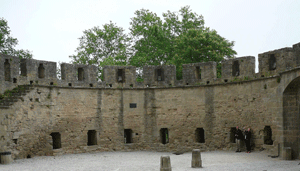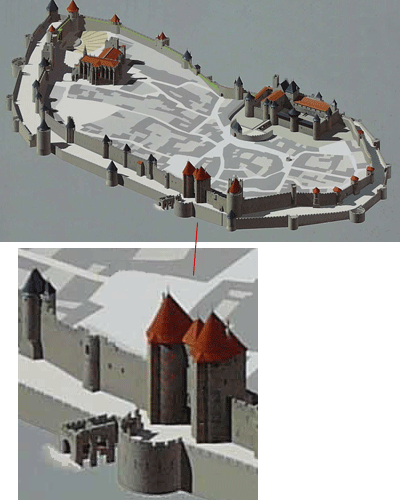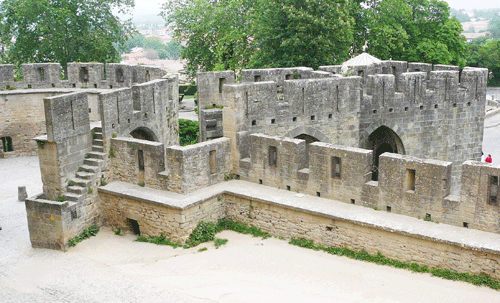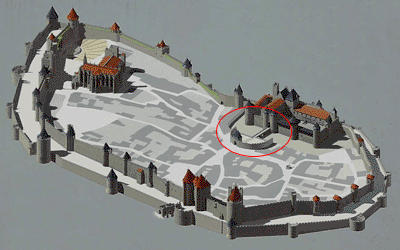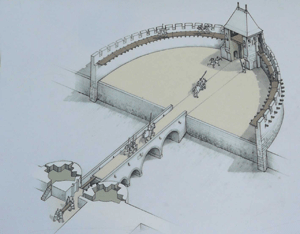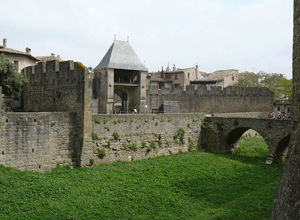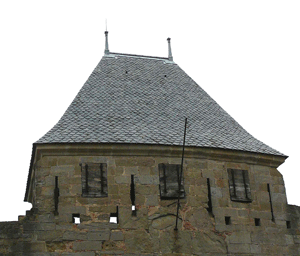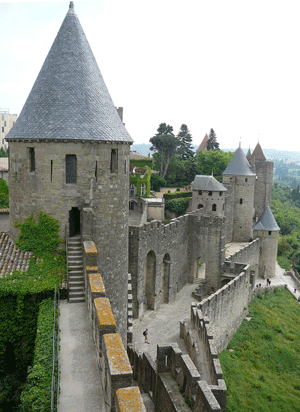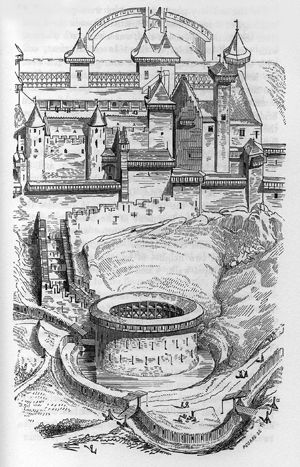Cathar Wars - Medieval Warfare - Barbicans
Barbicans are fortified outposts or gateways, typically
forming the outer defence to a fortified city or castle,
sometimes in the form of a tower situated over a gate or
bridge which was used for defensive purposes. (The name
comes from medieval Latin barbecana).
Usually barbicans were situated outside the main line
of defences and connected to the city walls with a walled
road called the neck. With improvements in artillery in
the 15th century, barbicans lost their importance. A few
barbicans were built in the 16th century.
The old Cite of Carcassonne possesses no fewer than four
barbicans along with the ruins of a fifth. They are all
different and give a good idea of the range of structures
described as barbicans.
Barbican at the Narbonne Gate
|
The main entrance to Carcassonne was the Narbonne
Gate, a substantial gate in the inner curtain wall.
It was defended by a barbican, shown on the right,
in the outer curtain wall.
|
This
is the inside of the semicircular defence, part
of the Barbican at the Narbonne Gate at Carcassonne.
This structure allows defenders to provide massive
covering fire to the adjacent fortified drawbridge.
|
|
|
|
|
|
A
Postern Gate at Carcassonne
|
|
|
|
|
|
|
|
Barbican
at the Narbonne Gate, Carcassonne
|
|
|
|
Barbican at the Chateau Comptal at Carcassonne from the
Cité
|
Illustration of the Barbican at the chateau
Comtale at Carcassonne, looking down from the
cite side of the exterior of the chateau
|
|
|
|
|
|
Illustration of the Barbican at the chateau
Comtale at Carcassonne, looking down from the
direction of the chateau
|
|
|
|
|
Photograph of the Barbican at the chateau Comtale
at Carcassonne, taken from the hourdes on top
of the chateau wall
|
|
|
|
|
|
Photograph of the Barbican at the chateau Comtale
at Carcassonne, taken from the dry moat just
by the chateau wall (ie below the point of view
of the photo on the left)
|
|
|
|
|
|
|
|
External view of the Barbican gate in front
at the chateau Comtale at Carcassonne (a fortified
gateway defending the barbican which is itself
defending the cite entrance to the Chateau Comtale)
|
|
|
|
Barbican at the Aude Gate at Carcassonne
|
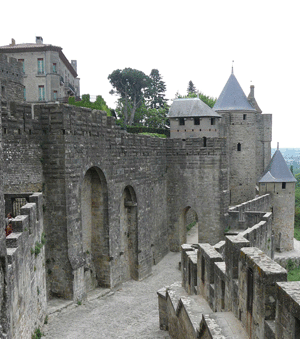
|
|
|
The
Aude Gate at Carcassonne
|
|
|
|
Barbican below the Aude Gate at Carcassonne
|
Although Carcassonne was supplied by a number of
wells inside the city, water could still be a problem
- as the siege of the cite in 1209 was to prove.
Carcassonne possessed an unusual external structure
providing access to the river Aude and dominating
the banks of the river. It is shown here in the right,
drawn by Violette le Duc in the nineteenth century.
The circular structure was removed and replaced by
a church, but the walled walkway remains and is accessible
to the public.
(You can make out two other barbicans in this diagram,
the Aude Gate and at the top the barbican of the Chateau
Comtale within the cite.
|
|
|
|
|
 Back
to: the Papal Inquisition Back
to: the Papal Inquisition |

|
|
|
|
